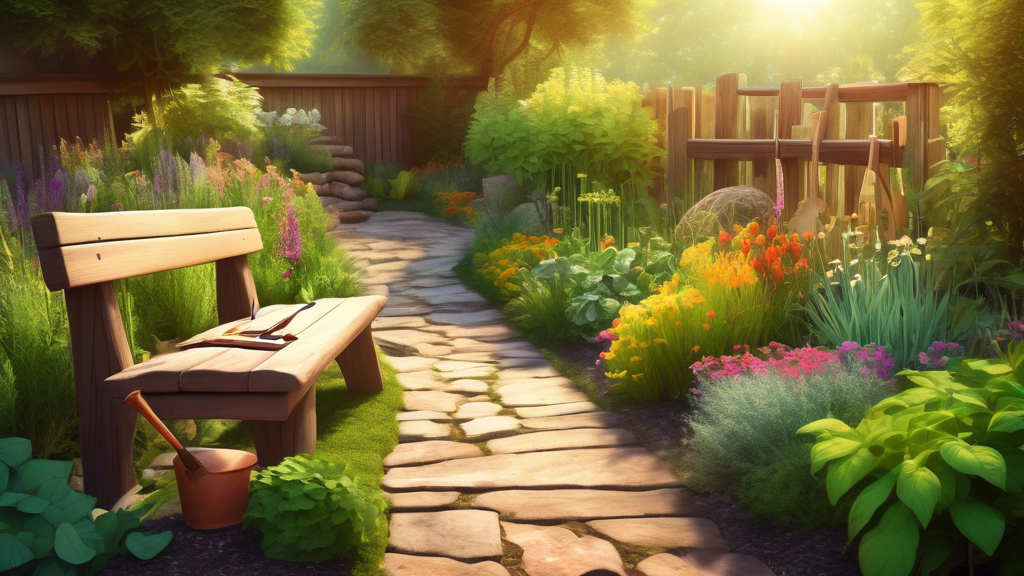
Why Your Herb Garden Might Be Causing Headaches
Many aspiring gardeners find their herb patch becomes a source of frustration rather than joy. Let’s diagnose the common issues.
The “Untamed Jungle” Look
Your herbs are thriving but look messy and overgrown, lacking any intentional design or structure.
Inconvenient Access
You have to trek across the yard in the rain just to snip some thyme for dinner, making fresh herbs feel like a chore.
Poor Plant Health
Herbs are competing for sunlight or are planted in soil that doesn’t suit their needs, leading to weak, spindly growth.
Aesthetic Clash
Your practical herb patch sticks out and doesn’t complement your home’s landscaping or patio decor.
Foundational Principles for a Gorgeous, Functional Herb Garden
Building a successful garden starts with understanding a few core concepts that marry aesthetics with plant health.
The Golden Rule: Right Plant, Right Place
Always group herbs by their sun and water needs. Mediterranean herbs like rosemary and lavender need full sun and well-drained soil, while moisture-loving herbs like mint and parsley can tolerate shadier, damper spots.
Play with Texture, Color, and Form
Think of your garden as a living painting. Combine the feathery foliage of dill, the rigid, spiky form of rosemary, and the soft, rounded mounds of lavender for captivating visual interest.
Design for Your Lifestyle
Tailor your garden to how you’ll use it. A “Kitchen Chef’s Garden” prioritizes basil, parsley, and cilantro by the back door. A “Cocktail & Tea Garden” might focus on mint, lemon verbena, and lavender.
Top Herb Garden Design Ideas: Combining Beauty and Functionality
Here are actionable design concepts to transform any space, from a sprawling backyard to a tiny balcony.
The Elevated Culinary Corner: Raised Beds & Planters
Raised beds offer perfect drainage, a clean, defined aesthetic, and are much easier on your back. For a modern twist, use tiered or geometric planters.
Charming & Compact: Container Gardens
Perfect for small spaces.
- The “Herb Trug” or Wheelbarrow: A mobile, rustic centerpiece that can follow the sun.
- Vertical Pallet Garden: Reclaim unused wall space on a patio or balcony.
- Themed Pots: Group “Pizza Herbs” (oregano, basil, thyme) or “Salad Herbs” (chives, parsley, chervil) in a single, colorful container.
Formal Elegance: The Patterned Knot Garden
For a touch of classic artistry, use low-growing, hedge-able herbs like boxwood, thyme, and santolina to create intricate, living patterns. This is beauty and functionality at its most historical and artistic.
Integrated Beauty: Blending Herbs into Flower Beds
Don’t isolate your herbs! Use rosemary as a fragrant, evergreen shrub border. Let the deep purple leaves of ‘Dark Opal’ basil provide a stunning contrast among bright flowers like zinnias or marigolds.
Herb Garden Showdown: Functional Design Comparison
Choosing the right structure and materials is key to a low-maintenance, thriving garden.
In-Ground Bed vs. Raised Bed
| Feature | In-Ground Bed | Raised Bed |
|---|---|---|
| Cost & Setup | Lower cost, less initial work | Higher upfront cost and labor |
| Soil & Weed Control | Harder to control soil quality and weeds | Complete control over soil; easier weed management |
| Accessibility | Requires bending and kneeling | Easier on the back; can be built to any height |
| Drainage | Dependent on native soil | Superior, well-draining environment |
Terracotta Pots vs. Glazed Ceramic Pots
| Feature | Terracotta Pots | Glazed Ceramic Pots |
|---|---|---|
| Watering | Porous, which helps prevent overwatering | Non-porous, retains moisture much better |
| Aesthetics | Classic, rustic look | Vast array of colors, styles, and finishes |
| Durability | Can crack or chip in freezing temperatures | Generally more resilient to frost if rated for it |
| Weight | Heavy, but manageable | Often very heavy, difficult to move once filled |
Pro Tips & Unique Insights You Might Not Know
Elevate your garden from great to extraordinary with these advanced concepts.
The “Thyme Lawn” Alternative
For a truly unique groundcover, replace a section of your grass with creeping thyme. It’s fragrant, drought-tolerant, handles light foot traffic, and explodes with tiny, pollinator-friendly flowers in the summer.
Companion Planting Power
Your garden can work as an ecosystem. Planting basil near tomatoes is known to help repel pests like tomato hornworms. Letting herbs like dill and fennel flower will attract beneficial insects like ladybugs and parasitic wasps that prey on common garden pests.
Edible Flowers for the Win
Don’t just stop at herbs. Intersperse edible flowers like calendula (with its bright orange petals), nasturtiums (with their peppery leaves and flowers), and borage (with its stunning blue, star-shaped flowers) among your herbs. They add incredible beauty, are edible in salads, and are powerful pollinator magnets that will increase the yield of your entire garden.
Frequently Asked Questions (FAQs)
What are the best herbs for a beginner’s garden that still looks good?
Basil, Mint (always in a container to control its spread!), Chives, Rosemary, and Thyme. They are notoriously hardy, incredibly useful in the kitchen, and offer a wonderful variety of textures and forms.
How do I keep my potted herb garden from looking leggy and sparse?
The secret is to “pinch and pick” regularly! Frequently harvesting the growing tips—even if you don’t need the herb immediately—encourages the plant to become bushy and compact instead of tall and spindly. Also, ensure your pots get at least 6 hours of direct sunlight.
Can I plant all my herbs together in one large planter?
You can, but you must be strategic. The key is to group herbs with similar water needs. For example, plant rosemary, lavender, oregano, and thyme together in one planter (they like it dry). Then, plant basil, parsley, cilantro, and mint in another planter (they prefer more consistent moisture).
What is a “guild” in herb gardening?
This ties into the unique insight of companion planting. A guild is a carefully designed community of plants that support each other, functioning as a mini-ecosystem. A classic example is a fruit tree guild, where you might plant comfrey (a “dynamic accumulator” that pulls nutrients from deep in the soil) and aromatic herbs like yarrow or chamomile around the base of a tree to improve soil health and deter pests.






